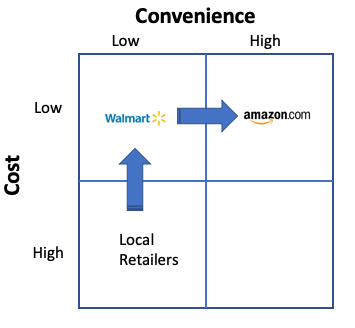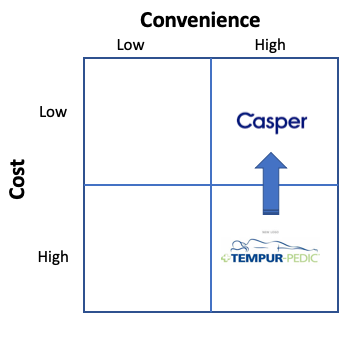Are you a cost or convenience innovator?
I like making up new frameworks to try to clarify my thoughts and try to explain observations in the startup ecosystem.
While I was taking a shower this morning before my kids woke up (prime thinking time), I started thinking about convenience and cost. Cost is pretty obvious. Convenience is all about customer effort to achieve the desired outcome or receive the desired good. It can include reliability, turnaround time, and delivery vs pick-up.
Of course these aren’t the only 2 factors that go into purchasing decisions, but they are two of the most important. Depending on the consumer, one will typically optimize for one or the other. Wealthy people tend to optimize for convenience. Less wealthy people tend to optimize for cost.
I started thinking about the successful startups (mostly e-commerce and marketplaces) and thinking about where they would fit on a handy 2x2.

Let’s look at a few examples.
- Amazon - increased convenience vs millions of small retailers (or Walmart)
- Wish - increased convenience vs dollar store or going to China
- Airbnb - increased convenience vs VRBO
- Uber - increased convenience vs taxis
- OfferUp - increased convenience vs Craigslist
- Netflix - increased convenience vs Blockbuster
- Ever lane - lowered cost vs Gap
- Casper - lowered cost vs Tempurpedic
- Lyte - increased convenience vs Stubhub
- Bus.com - increased convenience vs thousands of carriers





I believe there is always (and always will be) opportunities for companies that can either lower cost or increase convenience in large markets. It is a proven formula. The important thing for a company to determine is if they are a cost-innovator or a convenience-innovator. I can’t think of many examples that do both extremely well.
I think this can be powerful in simplifying a vision for a company. Pick one, execute well. Stay true to the brand promise. Ultimately, you’ll get an opportunity to do a little bit of both cost and convenience, but one of them is likely the primary driving force. The other one reinforces it and builds a bigger moat.